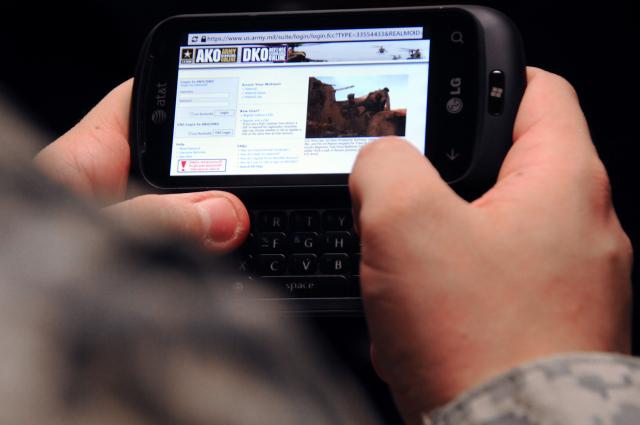As he maneuvered his squad across the desert, securing objectives in villages along the way, Staff Sgt. Jesus Vasquez tracked his squad’s movements not with a note pad or map, but with an Army-issued handheld device.
Flipping open the smartphone-like device worn on the front of his uniform, Vasquez tapped the screen to record what he saw — information that quickly traveled over the Army network to the rest of his platoon.
“We can plot anything from enemy positions to friendly positions to IEDs [improvised explosive devices],” Vasquez said. “It’s just like a phone — everybody these days has a smartphone, so it’s really easy to use.”
The Nett Warrior devices used by Soldiers like Vasquez during last month’s Network Integration Evaluation, or NIE, 12.2 aim to empower lower-echelon Soldier-leaders with unprecedented communications and situational awareness. Connected to the Joint Tactical Radio System, known as JTRS, Rifleman Radio and running the Army’s next-generation blue force tracking software, known as Joint Battle Command-Platform, or JBC-P, Nett Warrior provides dismounted leaders with the kind of digital information that today is only available inside vehicles or command posts.
The Android-based devices can connect to the Army’s larger tactical communications network through both the JTRS radio waveforms and the Blue Force Tracking 2 satellite network, leveraging a “gateway” in vehicles equipped with JBC-P. The Nett Warrior system aims to eliminate the time delay and human error associated with radio communications, instead giving Soldiers networked handheld devices to exchange messages and digitally track one another’s locations.
“If you’re on a radio, you have to listen, you have to write, you have to confirm — there’s a time delay process,” said Mark Frye, a retired first sergeant who is now Nett Warrior team lead at NIE. “If it is a published message on a handheld, we know how fast kids can text messages back and forth. It’s the same concept, but you’re doing it from Soldier to Soldier.”
During NIE 12.2, Soldiers evaluated Nett Warrior during a vigorous operational scenario that required the 2nd Brigade, 1st Armored Division to combat conventional enemy forces, insurgents, criminal elements and electronic warfare, stretching the brigade and the network across more than 100 miles of rugged terrain. With the formal operational tests for both Nett Warrior and JBC-P scheduled to take place at NIE 13.1 this fall, NIE 12.2 served to reduce risk by familiarizing Soldiers with the equipment and integrating it into the larger tactical communications network.
The up-front integration leverages the six-month NIE cycle and follows a pattern set by Warfighter Information Network-Tactical, or WIN-T, Increment 2, which was integrated into tactical formations at NIE 12.1 to provide an early operational look at the system prior to its Initial Operational Test and Evaluation, known as an IOT&E, at NIE 12.2. The NIE construct will also produce significant cost savings by combining key elements of the JBC-P and Nett Warrior formal tests.
“The NIE 13.1 architecture is designed so that we can instrument the systems to collect data on Nett Warrior and JBC-P,” said Lt. Col. Mark Daniels, product manager for JBC-P. “We’re going to be able to share data collectors and essentially we’re going to support one another’s IOT&E. Prior to NIE, that would be a rare thing.”
Extending the network to Soldier-leaders at the tactical edge through Nett Warrior is a key component of the Army’s Capability Set 13, the first integrated package of tactical communications gear that will be fielded to eight brigade combat teams starting in October.
Along with the ability to track and plot friendly forces, enemies and obstacles, the JBC-P software for Nett Warrior handhelds also provides Soldiers with various “apps” for everything from an address book to route planning to dropping a “chem light” icon on a cleared building. The chem light application evolved from units’ use of the real thing to designate areas as safe or dangerous, Frye said.
“When you see a bunker or building, you toss a red chem light in and that’s a danger area — that lets everybody know that’s possible enemy territory,” he said. “Once you have cleared the building, there was a green physical chem light that you painted or taped to the side of the building on the friendly side and it let everybody know that’s the good building. Soldiers came to us and said, ‘Hey we want that, but we want it digitally.'”
Today, the chem lights take the form of circular icons in four colors, which signify different threat levels based on each unit’s standard operating procedures.
“If the red chem light designates a building as danger area and that commander or platoon leader tells that squad to clear that building, once they’re done, on their handheld they turn it green,” Frye said. “Everybody has immediate feedback. You do not need to be on the friendly side of the building to see it — all you have to do is look at your display.”
The handhelds also allow Soldiers to take photos using an app for Tactical Ground Reporting, known as TIGR, which creates a historical database of people, places and events on the battlefield. Once sent through the network, the photos are available in the TIGR database to the rest of the brigade.
“Say we find a weapons cache — (we can) take a picture of it with this phone and get it right up on TIGR and get it right to higher (headquarters) as soon as possible,” Spc. Aaron Boatwright said. “That picture will also have a timestamp and a location on it, so there’s no denying where that picture came from.”











